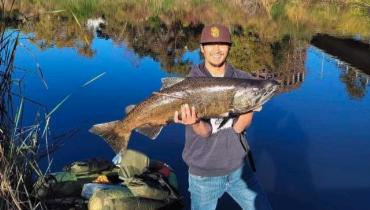WON hears from the angler and a salmon expert
BY MIKE STEVENS
SAN DIEGO— A local angler with only enough time to make a few casts before heading to work connected with a lot more than the largemouth bass he was hoping for, and it’s generating a lot of chatter in the Southern California angling community.
“Spin” Un of San Diego only had a 40-minute window to make a few casts in the San Diego River before clocking in to work, and on his first cast with a chatterbait he hooked up to something way more substantial than he could possibly have imagined. Along with bass and catfish, the San Diego River also holds big catfish and carp that can definitely have some weight to them, but what Un ended up landing was a mature Chinook salmon.
“I got down to the river and saw a man float tubing,” Un told WON an interview late last week. “I thought I should leave him alone because he was fishing already. But there’s only a few spots, so I made a cast and was reeling and the chatterbait and it stopped like I hit a rock. I snapped it a few times because I thought was snagged, and when I tried to reel it in it moved and it felt like a rock moving. After 10 minutes, I was thinking ‘what kind of fish is this?’ I thought it was a catfish or something when I saw the flash, and it felt like a catfish. When it got tired and got closer I saw it and thought it was a trout or something. When it got closer, I saw it had teeth.”
Un was fishing with 10-pound braid to 7-pound fluorocarbon, and he said the clip on the chatterbait was splitting and about to break when he landed the fish. The float tuber had front row seats to the battle and said he had been there since sunrise and fished all morning without a bite. He hopped out of the water to assist Un in taking some pictures.
Un thought it was a big catfish at first, but then saw it flash after about 10 minutes and thought it might be a big trout that somehow got in the river. Once it was landed, he noticed its big teeth and thought ‘how did it get here? Do they release salmon here?’”
While it was more of a news item in the northern half of the state, salmon fishing was shut down statewide in 2023 (and it could continue into 2024), and Un’s fish was returned to the river after some photos.
“Maybe last week’s rainstorm was enough to bring that fish in, but it looks like it has been in freshwater for a while based on how dark it is,” said Eric McIntire of Fishhead Custom Baits.
Salmon in Southern California waters are uncommon but not unheard of. Usually they’ll show up on a sport boat here and there (I’ve personally caught one on a half-day boat out of Oceanside), but stories of them showing up in Southern California rivers are very few and far between. Some SoCal creeks are historical steelhead waters, so if salmon were around and caught a whiff of that freshwater at the right time, one making its way upstream is clearly within the realm of possibility.
A day after connecting with the angler, WON also reached out to the Golden State Salmon Association (GSSA) for their input.
“Most likely, this was a confluence of events,” said Cat Kaiser of GSSA. “It is very rare, but not impossible. Salmon have a strong will to survive and to spawn; when, where, and how they do that can depend on many factors. That fish looks like it had been holding for a while, and rain may have created the ideal conditions to move into.”
Kaiser went on to tell WON that California salmon tags have been recovered up and down the coast. That includes a Half Moon Bay net pen salmon tag recovered in Yakutat, AK (approx. 1,700 miles from release location), while several other coded wire tags have been discovered south of the Santa Barbara Harbor. Small creeks throughout Northern California have salmon showing up for the first time in decades, some in record numbers.
“With changing ocean conditions, such as an abundance of anchovies that are spreading further south, more salmon in the ocean due to healthy hatchery practices and trucking, a closed ocean fishery, plus heavy rains, it is not a complete surprise that a salmon finding itself in Southern California and ready to spawn may have been drawn into the cold San Diego River after a storm,” said Kaiser. “I guess we’ll never know where it came from.”




